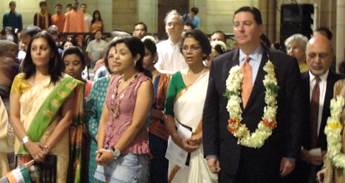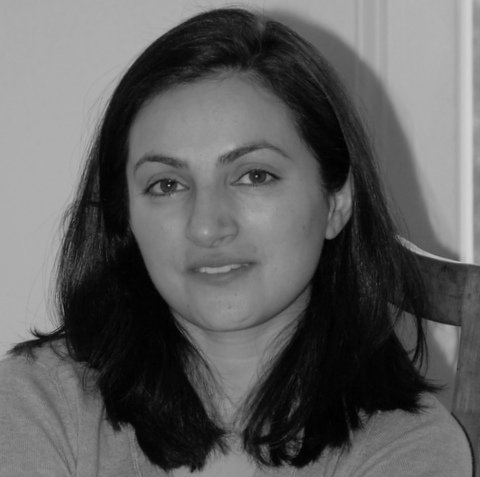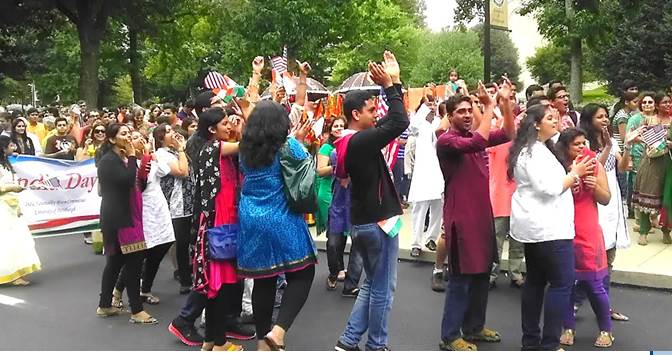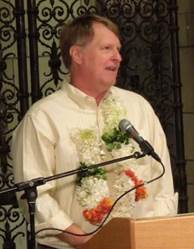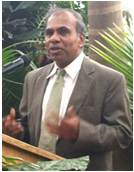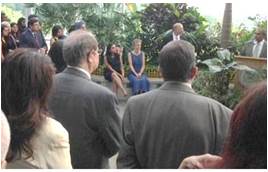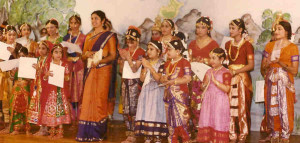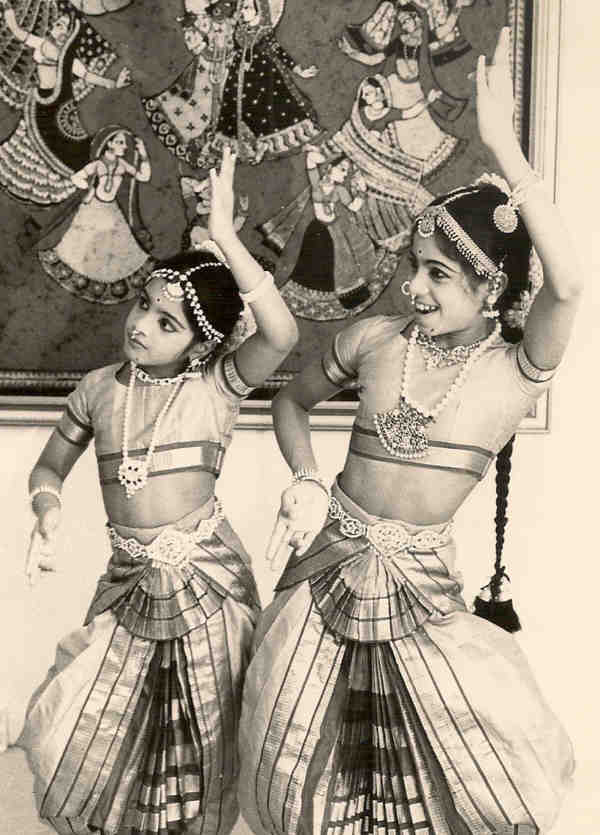Obituary: Dr. Harakh Vasanj Dedhia (1947-2013)
Posted by admin in January 2014 on December 25, 2013
Decades of Dedicated Service in Critical Care in Morgantown, WV
By Mohindar Singh Seehra, Morgantown, WVÂ Â e-mail: Mohindar.Seehra@mail.wvu.edu
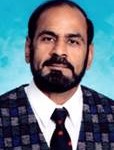 Dr. Harakh Vasanj Dedhia, 66, professor of medicine at the Health Sciences Center (HSC) of West Virginia University (WVU), and a prominent pillar of the Indian-American community in the Morgantown region in WV passed away on September 1, 2013 after a courageous battle with lung cancer. He was a non-smoker and a vegetarian.
Dr. Harakh Vasanj Dedhia, 66, professor of medicine at the Health Sciences Center (HSC) of West Virginia University (WVU), and a prominent pillar of the Indian-American community in the Morgantown region in WV passed away on September 1, 2013 after a courageous battle with lung cancer. He was a non-smoker and a vegetarian.
After graduating from the Grant Medical College, Bombay (1970), Dr. Dedhia completed his residency and fellowship in the US during 1972- 1977 in internal medicine. He joined WVU’s HSC as a faculty member in 1979, becoming the medical-surgical director of the intensive care unit (ICU) in 1983. His medical career was devoted to understanding and treating acute shock, acute respiratory failure and related problems of ICU patients.
An active researcher with over 140 publications and book chapters on critical care, he led over 30 single- and multi-center clinical trials. Well-liked by patients and colleagues, he received many awards from WVU Hospitals. A plaque reading “In grateful appreciation of our friend and colleague Harakh V. Dedhia MD for his years of service to patients in the medical intensive care unit at Ruby Memorial Hospital†will be placed at the entrance to the ICU. In honor of his parents, he established the WVU Sarkaba V. Dedhia Pulmonary Critical Care Fund, income from which is now used to train future doctors in critical care.
The funeral service at McCulla Funeral Home in Morgantown attended by over 200 people on September 3, 2013. Afterward Dr. Dedhia’s mortal remains were cremated following Hindu rites led by Shri Suresh Chandra Joshi of the Pittsburgh’s Hindu-Jain Temple. A Memorial Service celebrating Dr. Dedhia’s dedicated life was held on September 7, 2013 at the Riverside Apostolic Church in Morgantown. Following bhajan singing by family members and Shri Joshiji, colleagues, family and friends paid heart-felt tributes to Dr. Dedhia for his inspiring humanitarianism, humility and pride; and for his compassion towards working for the greater good. A prayer by Anuja (Dr. Dedhia’s wife) and a 2-minute silence for the departed soul followed by prasad concluded the ceremony.
Dr.Dedhia leaves behind his loving wife Anuja, three sisters & four brothers & their families living in India and the U.S, and a large number of friends. He was inspired by the Jain-Hindu spiritual ethos and traditions.  ♦
Obituary: Rama Karamcheti (1948-2013), Librarian
Posted by admin in January 2014 on December 25, 2013
By Rama Kalipatnapu Rao     e-mail: ramakrao65@gmail.com
Rama Karamcheti, 65, a resident of Washington, PA passed away on October 2, 2013 in her home after battling multiple myeloma for seven years. She was born on February 22, 1948 in Vizianagaram, Andhra Pradesh, India. Her father was a WW II veteran as a physician. In 1969 she married in India Anand Karamcheti, a physician. She came to the US in 1972 with her husband and had two sons Aditya and Deepak. They lived in Morristown, NJ, New York City, and Pittsburgh, before settling down in 1977 in Washington, PA where Anand set up his urology practice.
In 1982 Rama earned her Master’s degree in Library Science from the University of Pittsburgh, attending classes by commuting from Washington, PA to Oakland. For ten years, she was the head of the reference department at Ohio County Public Library in Wheeling, WV. Later, she was a reference librarian at Citizen’s Library in Washington, PA. As a librarian, she provided remarkable service to the community.
She battled multiple myeloma, which was diagnosed in 2006.  Rama’s simplicity, courage and incredible endurance, serene demeanor, hard work, elegance, friendly nature, and positive outlook are well known to her friends. She never complained of fatigue or other signs of poor health, and kept herself busy with light household activities, grandchildren and friends. She found joy in taking her grandchildren to swimming pools, parks and reading stories from scriptures. She enjoyed helping an ailing friend in need, or having an informal soup party with friends at her home or going out with friends. She never worried about how she was going to be the next day and found joy in spending time with family and friends.
Rama’s parents, Venkata Ramaniah and Suryakantham Praturi, died a few years ago in India. Rama is survived by her husband Anand; elder son Aditya and his wife Erenia; younger son Deepak and his wife Manjula; grandchildren Ram, Anand Jr, Jaya and Kush; and her sisters Shanta in India, Aruna in Boston and brother Srinivas in India.
After a brief private funeral service, Rama was cremated at the Washington Cemetery in Pennsylvania. Rama’s demise is a great loss to her family and her many friends. ♦
Ummm mmm mmm… …
Posted by admin in January 2014 on December 25, 2013
Football folks are heroes when they deliver. But when they perform poorly, God save them. All these years, Mike Tomlin was a hero. Earlier this season, Tomlin was hauled over burning coals in the local media.
Half way through the season he was interviewed in November after the disastrous 31-55 loss to the Patriots and a pitiful 2-6 performance.
Tomlin was asked about his confidence in his defensive coordinator Dick LeBeau following the worst statistical performance. The Steelers allowed a franchise-record 55 points and 610 yards against the Patriots.
Reporter: Do you still have confidence in Dick LeBeau’s ability to stop opposing offenses?
Tomlin: Certainly.
Reporter: Why?
Tomlin was terse “Because he’s Dick LeBeau.†He continued: “Does that answer your question?â€
If only corporate executives, mayors, and elected church and temple officials would get such “Whys†when their organizations perform badly.
Here is another:Â Jonathan Dwyer, a reserve running back in his 4th year with Steelers, was let go last August. Unable to find a place on any of the other NFL team, he was unemployed.
With a long list of injuries this season, Steelers re-hired Dwyer in November. Dwyer performed well against the Browns, rushing for 139 yards, averaging 4.8 yards per carry. Tomlin lauded him for the good job.
When asked if Dwyer has changed because the Steelers released him in late August, Tomlin said, “I would imagine unemployment does that.â€
That is how brutal and humiliating the working environment is in NFL. Would you like to work in an environment like that?
Chanakya’s Sayings:
Chanakya was the advisor for Chandragupta Mourya in the 3rd century before the Common Era, and wrote Artha Shastra, perhaps the oldest book on statecraft.
Who did not become arrogant with wealth and riches? Which person given to cravings had an end to his troubles? Whose heart has not been hurt by women? Who has been dear to rulers forever? Who has escaped the stealthy march of Time? Which beggar has dignity? Who, fallen in bad company, has travelled safely in life?Here is another Gem from Chanakya:
Proximity means disaster, and being far away is not helpful either. So, work from the middle with kings, teachers, fires, and women.From Bhartrhari — Sanskrit Poetry on the Way of the World;
The Sanskrit poet Bhartrhari lived in the 5th century near Ujjain (near Indore, in today’s Madhya Pradesh India). A collection of 300 verses of his, Tri-Satakam (literally Three Hundreds), is well known to anyone who has a vague familiarity of Sanskrit and classical Hindi literature. His Tri-Satakam is divided into Niti (proper conduct), Srngaram (sensuality) and Vairagyam (dispassion). Here is one in its original for you to enjoy or ruminate, on which novels are written and films made all over the world:

Here is the translation:
She who I am constantly thinking about is indifferent to me;
And is desirous of another man.
This other man adores some other woman,
who, in turn, takes delight in me.
Damn her! Damn him! Dam the God of Love!
Damn the other woman! And damn myself! Â Â Â ♦
Lead Story: President Obama Buys Time & Averts a Crisis
Posted by admin in October 2013 on September 29, 2013
By Kollengode S Venkataraman
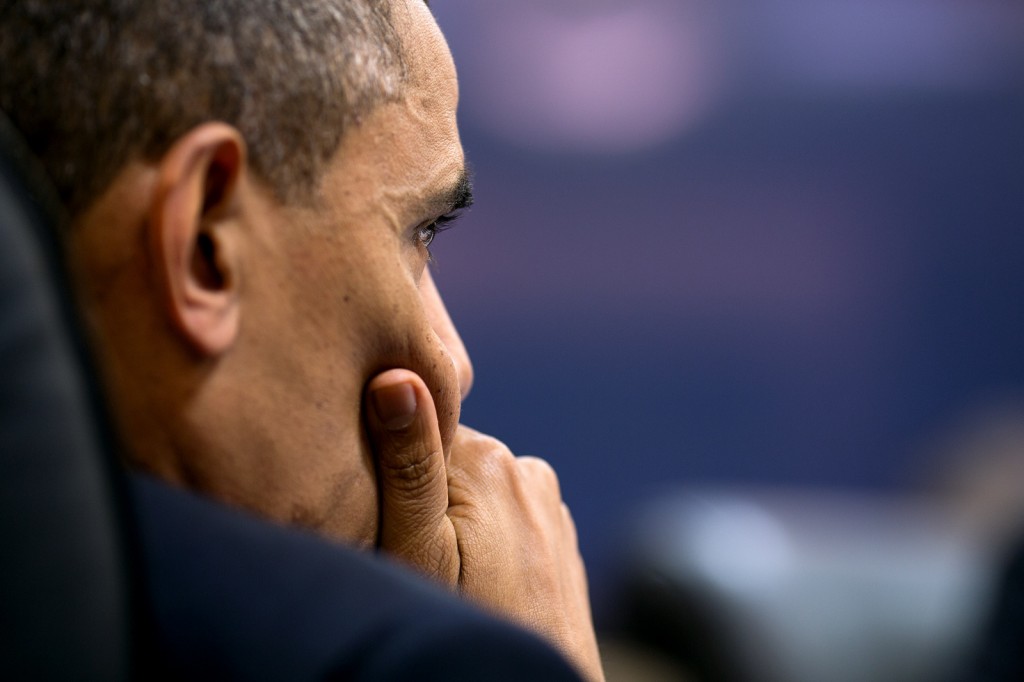 In his talk to the nation on September 10 President Obama, recognizing the lack of support, wisely asked the Congress to postpone the vote granting him the power to attack Syrian President Assad for using chemical weapons on his citizens. President Obama opted instead to use the opening Russia gave that seeks to disarm Syria without US military attack. This buys Mr. Obama time to think through all possible fallouts of such a unilateral and limited surgical missile attack by US forces with “no-boots-on-the ground.â€
In his talk to the nation on September 10 President Obama, recognizing the lack of support, wisely asked the Congress to postpone the vote granting him the power to attack Syrian President Assad for using chemical weapons on his citizens. President Obama opted instead to use the opening Russia gave that seeks to disarm Syria without US military attack. This buys Mr. Obama time to think through all possible fallouts of such a unilateral and limited surgical missile attack by US forces with “no-boots-on-the ground.â€
It is not even clear who used the chemical weapons—the Syrian military under Assad’s orders, rogue Syrian military officers or the rebels.
The US record on matters of chemical weapons is not all that clean. We turned the other way when Saddham Hussein used chemical weapons against Iran in the 1980s. In the 1960s and 70s, in Vietnam US used napalm bombs on nonmilitary targets with devastating effects, and sprayed defoliants over large areas of forests and farm lands—a form of chemical warfare—whose effect was tens of thousands of Vietnamese women delivering babies with grave abnormal deformities.
George W. Bush had with him the tenuous Coalition of the Willing in his war against Iraq when he did not get the UN support. Now Obama was about to become the missile-slinging Lone Ranger planning an attack on Syria in what he calls a surgically precise, short-duration aerial combat. He had no support from other nations (including the “special relations†Britain), the UN Security Council, US Congress or the American public.
Rationalizing his resolve for a military assault on Syria, Obama also said, “[G]overnments representing 98 percent of the world’s population said the use of chemical weapons [is] abhorrent.â€Â If nations representing 98% of the population have signed the treaty against chemical weapons, why does the US representing only 5% of the world population have to go alone? Where are the nations representing the remaining 93%—the Arab League, our Persian Gulf and NATO military allies, Saudi Arabia, Turkey, and Iraq where we waged a 10-year war with almost 4,500 dead US soldiers, over 30,000 wounded soldiers requiring care for the next several decades, not to speak of the several hundred thousand Iraqi civilian deaths? And the Iraq war cost us over a trillion-dollars so far. After all, our Arab military allies and friends in the region have been benefitting by the American military involvement there without spilling a drop of their own blood.
Just because Mr. Obama drew the red line arbitrarily, he wants the war-weary Congress and the citizenry to support him for one more military adventure in a region where US blood has been spilling for over 10 years, and where our credibility is already low. Is this how the leader of the Sole Super Power should go about making decisions on war?
Oh, by the way, we will exceed our debt ceiling in the next several weeks, and the federal government is already in sequestration, we are barely out of a deep economic downturn with anemic new job growth, and we have mounting budget and trade deficits; and we have to take care of so many domestic problems we have been neglecting for over 15 years.
To understand the conundrum of the Syrian Situation and how intractable the Middle East is, go here. Do we really want this war?  ♦
Bill Peduto Slated to be Next Mayor Pittsburgh
Posted by admin in October 2013 on September 29, 2013
By Kollengode S Venkataraman
With a 4:1 voter advantage for Democrats, Bill Peduto, the Democratic mayoral candidate and a member of Pittsburgh City Council, is expected to win easily in November. Peduto won easily in the Democratic primary in Spring 2013 defeating his main rival Council President Jack Wagner in a 4-way primary. The last time Pittsburgh had a GOP mayor was in the 1930s!
Peduto has name recognition, political savvy and gravitas, a good grasp of the region’s politics and economic challenges, and a stronger war chest than his GOP rival.
Bill Peduto is familiar to Indian-Americans interested in public life at the city and county levels. Several times we have covered in the past his a presence at the podium in the annual India Day melas at the Cathedral of Learning. He knows the Indian-American Diaspora here only too well. In the photo above, Peduto is with volunteers in the India Day in August 2013.
Peduto’s has been a progressive and also fiscally responsible voice in Pittsburgh City Council. He understands Pittsburgh’s many challenges—city finances, urban revitalization, and retaining existing businesses and bringing new businesses into the city. Another challenge is making Pittsburgh attractive for our young men and women raised here, and for young professionals from outside to move here.
One also hopes the future Peduto administration will make it easy for suburbanites to come to the city during weekends and evenings to enliven the city’s night life beyond the South Side. One of the biggest annoyances for suburbanites—the region’s population is over 2 million while the city’s is only 300,000—is the exorbitant city parking fees during evenings and on Saturdays. More people coming into the city will revitalize the city’s ambiance during weekends and evenings and expand the city’s retail and hospitality businesses, and help to bring in more tax revenue.
Peduto is endorsed by the region’s political heavyweights—County Chief Executive Rich Fitzgerald, Democratic elected officials and unions. Their goodwill is critical to set the tone of his administration. The influential nonpartisan Common Cause too gave Peduto “The Champion of Good Government†award in 2012. We wish Bill Peduto well.  ♦
The Need to Recognize Depression in Youth
Posted by admin in October 2013 on September 29, 2013
Dr. Mani Balu, Monroeville, PA
e-mail: balus61@gmail.com
Editor’s Note: Dr. Mani Balu is one of the early Indians to settle down in Southwest Pennsylvania. For over three decades he practiced pediatric medicine in Union Town, PA. After retiring from his practice, he and his wife Shantha now live in Monroeville. PA.
On May 27, 2013 we lost our dear daughter Geetha, 35, to depression. She ended her life after suffering from depression for fifteen long years.
This article is not intended to publicize her illness or our grief. As a father and a pediatrician, my aim through this article is to make people aware of depression.
In general, people do not recognize depression in themselves or in their loved ones early. Even if they suspect it, either they neglect it, deny it or think that it is due to some other illness and put the person through many medical tests. As a pediatrician, I see this problem in my patients, when the teenagers are brought to me with symptoms suggestive of depression. When I tell the parents that I suspect depression in their daughter or son, neither have they believed it nor wanted to accept it. As a result of this, the diagnosis and proper treatment are delayed or even denied. I hope this article will help everyone understand the problem and seek medical help promptly.
First of all, we need to understand that depression is a chronic disease due to chemical imbalance in the brain. As of yet, we do not know the cause of this. It is more common in girls. It has a genetic predisposition too. If a parent, grandparent, sibling or other close relative has or has had this problem, we should realize there is more chance for the youth to have depression.
More importantly, as the causes of depression are not known, there are no preventive measures. So please do not feel guilty that you could have done something more to prevent it.
Realizing the seriousness of depression and the importance of its early detection and proper and prompt treatment, the American Academy of Pediatrics has instructed all pediatricians in the United States to ask the following questions to all girls and boys between the ages of 15 and 18 years to diagnose the condition early, during their yearly physical check ups. (Depression can start earlier or later also.)
- Do you have little interest or pleasure in doing things?
- Do you feel down, depressed, irritable or hopeless?
- Do you have trouble falling or staying asleep?
- Do you feel tired or have little energy to do things?
- Are you experiencing poor appetite, weight loss, overeating or weight gain?
- Do you feel bad about yourself or feel you are a failure or have let yourself and your family down?
- Do you have trouble concentrating on things, such as schoolwork, reading or watching TV? Do you avoid friends and prefer to be alone most of the time?
- Do you move or speak so slowly that other people notice OR conversely, are you fidgety, restless and worried all the time?
- Do you have thoughts that you would be better off dead or would like to hurt yourself in some way?
Hopefully this article will help in the early diagnosis and prompt treatment of someone who may be suffering.
As for Geetha, she herself suspected that she might have depression when she was living in the college dorms and she told me about it. The diagnosis was confirmed soon and the treatment was started promptly.
For fifteen long years, she had all kinds of treatment: Allopathy, Homeopathy and even Tirupati (Venkateshwara). Hers was a severe case of depression which took her away from us.
I still feel confident that, in the future, we will have a better understanding of the disease with better outcomes. So please, do not give up hope. ♦
Miss America Pagent 2013 — American Identity, Always a Work in Progress?
Posted by admin in October 2013 on September 29, 2013
 By Kollengode S Venkataraman
One can deal with people who are ignorant but not arrogant — we can inform them.
One can deal with people who are arrogant but not ignorant — we can level with them.
But it is difficult to deal with people who are both ignorant and arrogant.  And people who are both ignorant and arrogant are in all demographic groups and subgroups.
Add hate to this combination and you have a combustible mix.  All it needs is a simple trigger. A few days after September 11, 2001 a pack of young men screamed at my daughter, “You Arab, go home,â€Â at Miracle Mile Shopping Centre’s parking lot in Monroeville, a Pittsburgh suburb.  My daughter in her early twenties then and a quintessential product of the social and education system here shouted back, “I’m Indian, you moron!â€
It happened again after the Indian-American Nina Davuluri, born and raised in the US, was declared Miss America in the pageant. She was the first Indian-American to get this title. Granted, beauty pageants, mercifully have lost their luster in many parts of the world. These days, increasingly brains – not beauty defined by the multibillion dollar fashion industry in the Western world – is the yardstick coveted by young women everywhere. Thank Almighty God for this change.
No sooner than Davuluri got the title, social media was lit with racist comments steeped in ignorance, arrogance, and hatred. Here are the samples reproduced verbatim (including profanity and grammar mistakes):
- And the Arab wins Miss America. Classic.
- How the f@#$ does a foreigner win Miss America? She is a Arab!
- 9/11 was 4 days ago and she gets miss America?
- Miss America right now or miss Al Qaeda.
- Congratulations Al-Qaeda. Our Miss America is one of you.
- So miss America is a terrorist.
- Miss America? You mean miss 7-11.
- Miss America, footlong buffalo chicken on whole wheat. Please and thank you.
- Man, our president nor our new Miss America isn’t even American…
True to the American spirit, one must also acknowledge, a whole lot of people were also aghast at these comments as one could see in the readers’ response to these comments.
Going beyond these external responses, there is a larger and more important message to Indians living in different parts of the world: For Indians – and Indian-Americans — obsessed with equating beauty with pale, “wheatish†complexion, the choice of Nina Davuluri with her dusky chocolaty complexion would have come as a rude shock, which, in due course of time, I hope, would evolve into a revelation and self-discovery.
After all, traditionally Indian classics always describe dark skin tone in luscious and sensual terms. Shyama-sundari, common name for women, literally means in Sanskrit “a dark-complexioned beautiful young woman.†Shyamali is also another common name for girls. Shyam-sundar is an affectionate epithet for Krishna, literally meaning “a dark-hued handsome young man.â€Â Saraswati, the Hindu Goddess of knowledge and fine arts, is dark-complexioned — kaar mukil meni in Tamil — as described in one of the prayers.
One hopes Davuluri’ s choice slowly reverses the trend among both young and older Indians’ perception of beauty that  forces young Indian women to apply Fair and Lovely, the peroxide-loaded chemical bleach to look pale, which leads to all kinds of skin problems.
Now that the Gora Duniya of USA, by selecting the Kali Desi Nina Davuluri as Miss America, has acknowledged that a darker skin tone (shyama) is just as beautiful, one hopes that Indians in India and even Indian-Americans here will start seeing beauty in their countless natural shades of darker skin tones – Like Indians running to yoga studios and meditation retreats after the Caucasian world acknowledged their merit. ♦
Working to End Violence Against Women
Posted by admin in October 2013 on September 29, 2013
By Namita Luthra, New York, NY. Â
e-mail: namitaluthra@gmail.com
Editor’s Note: Namita Luthra, a civil rights lawyer, lives in New York City with her husband Anil Shrivastava and their two children, Amartya and Jaya. She grew up in Weirton, WV, near Pittsburgh.
“Everyone deserves love, laughter, and joy in their lives. No one deserves to live in fear.†— Radha, a survivor of domestic violence.
To end violence against women. That is the simply stated but ambitious mission of Sakhi for South Asian Women, an organization founded twenty five years ago in New York City that assists survivors of domestic violence. Sakhi, meaning woman friend in Sanskrit, takes a two-pronged approach to achieving this mission:
First, it creates a safe place with a full range of culturally sensitive, language-specific information, support, services, and advocacy for South Asian women facing abuse in their lives.
Secondly, it works to inform, actively engage, and mobilize the South Asian community in the movement to end violence against women forever. Though its mission is far-reaching, Sakhi works to make it a reality one woman at a time.
In 2012, Sakhi served nearly 600 women who reached out through its helpline, website, or a referral. Here is a glimpse of one life of a survivor named Radha, in her own words:
“Growing up, my home was filled with laughter, love, and joy. My parents were like normal Indian parents and expected the best from us in terms of grades, manners, and respect, but they always made us feel cherished and supported
Even on my wedding day, my mom held my hand before I walked towards the mandap and told me that she would always support my decisions and always stand by my side.
After I married, my home was filled with sadness, disrespect, and fear. My husband ruled the home like a tyrant and used his words and hands to instill fear in me. He wouldn’t allow me to see family or friends. And soon I was isolated, alone, and afraid.
Sakhi helped me move past my assumptions that I would shame my family and, society would view me poorly if I were divorced, and helped me move forward in my life. Sakhi helped me get a lawyer and held my hand in court. My mom stood by her word and held my other hand.Â
I am now happily married to a wonderful man and have two very loved children. With the support of Sakhi and my loving family, my home is filled with laughter, love, and joy once again.â€
My own involvement with Sakhi is a longstanding one. In 1996, after receiving a law degree from the University of Pittsburgh School of Law, I moved to New York City for a civil rights legal fellowship with the American Civil Liberties Union. At the same time, I began a volunteer position with Sakhi. As a volunteer, I helped survivors of violence navigate the criminal justice and civil law systems. In 2012, I joined Sakhi’s Board of Directors and now help set its development and program priorities.
At Sakhi’s helm is Tiloma Jayasinghe, its Executive Director, who has steered Sakhi in bold and new directions. In addition to strengthening its local focus, Tiloma now ensures Sakhi’s role in a national and global conversation about reframing anti-violence work.
Other vital members of the Sakhi team include Community Outreach and Domestic Violence Program Advocates and an Economic Empowerment Coordinator. This spring, Sakhi along with other South Asian women’s organizations, was present for President Obama’s signing of the reauthorization of the Violence Against Women Act. Two years ago, Sakhi hosted a summit for international and national social justice leaders to understand intersections between immigration, economic dependence, and gender violence and set forth positive goals for the movement.
This year, Sakhi celebrates its 25th Anniversary. It marks this milestone with several events during the year including a gala reception in May 2014. In past galas, Sakhi has honored dedicated supporters including film director, Mira Nair, a United Nations Special Rapporteur on Violence Against Women, and most recently this May, Ann Mukherjee, Senior Vice President of Frito Lay, who spoke compellingly about her own history of surviving violence.
Sakhi could not exist without generous support from a committed South Asian community in the New York metropolitan area. The Pittsburgh and Tri-State South Asian community can contribute to Sakhi’s vital work, too. A contribution from you, no matter how large or small, will help Sakhi achieve its mission – one woman at a time. Join our mailing list to learn more about Sakhi’s important work, receive updates about 25th Year events, or support Sakhi, by contacting Danielle Reydon through Sakhi’s website: www.sakhi.org. By supporting our work, you could take pride in helping to end violence against our fellow sakhis – Indian, Pakistani, Sri Lankan, and other South Asian women. Women like Radha. ♦
The India Day Celebrates Everything Indian
Posted by admin in October 2013 on September 29, 2013
By David Downey  Â
e-mail:Â : DPD25@pitt.edu
Editor’s note: David is a senior at the University of Pittsburgh majoring in Philosophy. He also works at the Nationality Rooms Program. David hopes to see more India-related events.
On Sunday, August 18, hundreds of people gathered at the Cathedral of Learning on the University of Pittsburgh campus. Although the sky was overcast, smiles were everywhere as people prepared for the 16th India Day’s festivities, celebrating India’s culture, heritage and ancestry coinciding with the 66th anniversary of India’s independence. This year’s festivities highlighted Subhash Chandra Bose.
The festival began outside with a parade around the grounds of the Cathedral with Keerti Gaulati welcoming crowd and singing the Indian and American national anthems. A truck carried powerful speakers that put forth both Indian music and the rallying words of the parade. The music was accompanied by a variety of hand-held percussion instruments, as well as the cheers of marchers and spectators with the marchers in the front spontaneously dancing to the upbeat tunes. The half-hour parade drew several pedestrians into the Cathedral to see what was going on.
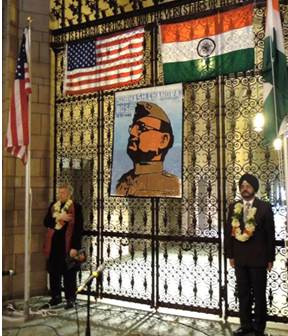
University of Pittsburgh Chancellor Nordenberg and Indian Army Brigadier (Retd) Nawab Singh Heer after the flag hoisting.
The program booklet was a work of art in itself, with messages from leaders in Pittsburgh’s community, a summary of the life of Netaji Subhash Chandra Bose, a timeline of India’s history, and advertisements for Indian restaurants and businesses.
Although many festival goers were dressed casually, many others wore traditional dress with many women in brightly colorful saris. The extravagant ornamentation of the dresses brightened the grey limestone halls of the old Gothic building. The Commons Room became even more lively as music and dance performances alternated with speeches.
The two-hour program started with people singing the American and Indian national anthems as the Stars and Stripes and the Indian Tricolor flags were hoisted. People celebrated their freedom to exercise both Indian and American identities, and how cultures are able to celebrate and complement each other. Speakers included Chancellor Mark Nordenberg, Councilman Bill Peduto, County Commissioner Rich Fitzgerald, Meena Muthyala, Kaushik Mitra, and Chelsea Pallatino.
Speeches addressed everything from Indian history and freedom, making a new home in Pittsburgh and the US, climate change, and maintaining a rich cultural heritage and working together as a community.
These elements are all exemplified by the Indian Nationality Class-room on the third floor of the Cathedral that
was opened in early 2000. The classroom cost tens of thousands of dollars raised by the Indian community in the region. The dedication required to build a classy teaching room is proof that the speakers’ words rang true. The room was open to visit, and many took time to appreciate its representation of the ancient classroom.
The classroom also continues to give, as made clear by the speech by Chelsea Pallatino, this year’s winner of the Indian Nationality Classroom Scholarship, which enabled her to travel to India. Chelsea worked with Share India to assist health issues in the Medchal Mandal area. This experience allowed her both to experience rich Indian culture, and give back to those people by improving health conditions. The dances and songs performed by various ages kept the festival atmosphere alive.
In addition to the speakers and dancers in the center of the room, various tables lined the perimeter. There were several arts and crafts tables for children, with people indulging in the Indian food available. There were multiple booths inviting philanthropy. These were hosted by Overseas Volunteers for a Better India, The Association for India’s Development, and The Bengali Association of Pittsburgh. The event was also sponsored by The U.S. India Forum. Finally, there was a table selling finely decorated saris, and another selling books. The books covered biographies, history, religious scripture and meditation practices.
The effort and planning required for an event such as this were no challenge for the motivated enthusiasts of Indian culture and heritage. ♦
A Very Unusual Last Goodbye
Posted by admin in October 2013 on September 29, 2013
By Cindy Koller, West Newton, PAÂ
e-mail: ckoller@andrew.emu.edu
Note: Cindy Koller proofreads and copyedits most of the articles in the Patrika. When you still find typos here and there, it is because we did not send those articles for her critical look on account of time constraints. — Editor
Just recently my husband’s cousin Ernie died. Ernie was 96 years old and died while doing one of the things he loved most—working in his garden. A long life lived well to the very end. Ernie leaves behind Rose, his wife of 59 years; five children; eight grandchildren and a great-grandchild, as well as many nieces, nephews, cousins and friends.
Plans for Ernie’s funeral and burial were well-thought out and pro-ceeding well until the unimaginable happened: the day after Ernie died, Rose fell and broke her hip. This required immediate hospitalization and surgery. Rose was already distraught at Ernie’s unexpected passing.
But now, being unable to attend the viewings, funeral services and burial were causing Rose and her family a great deal of emotional pain.
Well, if Mohammed couldn’t come to the mountain, the mountain would have to come to Mohammed. And come it did.
Through an incredible act of care, compassion and cooperation, the funeral home and the hospital devised a plan. After the viewings and church service were over, instead of proceeding directly to the cemetery, the hearse journeyed to the professional building attached to the hospital where Rose was a patient. A room there was arranged as a make-shift funeral parlor. Ernie’s casket was brought in and re-opened and his body was gently prepared for an ‘encore’ viewing by his wife.
When all was ready, Rose arrived in a wheelchair to have her final visit with Ernie and take her leave of him. Family, pall-bearers and close friends were invited to attend this special viewing.
After Rose gently scolded Ernie (“You know I was supposed to go first!†she said to him) and expressed her parting thoughts, all the rela-tives got in line to greet Rose and take one last leave of Ernie. She talked and visited with each person.
With this unusual arrangement, Rose got that all important closure that would have been denied her had the funeral home and hospital stuck to rigid formalities and policies.
This generous act of humanity and cooperation afforded a grief-stricken widow and her children an opportunity for closure and peace. It was our privilege to have been able to participate. And it is a testament to both the hospital and the funeral home that they bent a few rules to provide comfort and solace to this family in their time of grief.  ♦
Are There Any Truths in Mythological Stories?
Posted by admin in October 2013 on September 29, 2013
By Kollengode S Venkataraman
There was a story by Laurie Goodstein in the July 20th issue of The New York Times (http://tiny.cc/Mormon_Doubt) focusing on an intrafaith challenge: When Mormons search the web for reinforcement and clarifications in their faith, they end up with doubt and disillusionment because of the historical anomalies, inconsistencies and church practices between what they hear in their tightly managed churches and read in the Mormon Bible, and what is widely available on the Internet.
Goodstein quotes a deeply religious Mormon overseeing the Mormon Church’s European operations: “I felt like I had an earthquake under my feet. Everything I’d been taught, everything I’d been proud to preach about and witness about just crumbled under my feet. It was such a terrible psychological and nearly physical disturbance.â€
A few days later, Harold Kushner, a Conservative Rabbi and the author of the bestseller When Bad Things Happen to Good People, chimed in advising Mormons on how Judaism deals with inconsistencies in its Bible, the Old Testament, compiled a few thousand years before the Mormon Bible’s time (Letter to The New York Times, July 23). The rabbi writes:
“Might I suggest that they [Mormons] use the tactic used by many modern Jews dealing with biblical narratives that defy credulity, from a six-day story of creation to Jonah living inside a large fish. We [Jews] distinguish between left-brain narratives (meant to convey factual truth) and right-brain narratives (meant to make a point through a story).â€
The rabbi goes on: “The message will be true even if the story isn’t factually defensible.†Modern Jews’ efforts to reconcile credulous events in their Bible with their skeptic members today are understandable.
In this background, we hope—and also expect—that the Abrahamics extend the same approach when they study mythologies in other systems of beliefs instead of showing condescension and derision.
In any case, there is nothing “modern†or original in modern Jews’ attempt to reconcile the incredulous with the cerebral. In fact, this is the very basis of stories in Indian and Greek mythologies, and in the Sufi stories that came over 1500 years later. In all these stories, even when the narratives themselves are incredible and truly fantastic, the kernel messages they convey are valid for all times and in all places.
So, here is an example of a story I heard in the Bhagavatam discourse by Shantananda at the Chinmaya Mission in August:
In the Hindu cosmology, time is divided into four sequential yugas or epochs, called the Satya or Krta, Treta, Dwapara, and Kali yugas, with each yuga thousands and thousands and thousands of years long. But that is not important here.
In the Satya Yuga, the noble and the evil people lived isolated in different worlds. In the Treta Yuga (Ramayana’s time), the noble and evil people came closer—in different land masses on earth separated only by water. The noble Rama was in India and the evil Ravana in Lanka, separated by water. In Dwapara Yuga, the evil and noble people became closer still—cousins of the same family, as the noble Pandavas and the evil Kauravas. In the Kali Yuga (our time), the Noble and Evil are the closest they can ever be—the two are in all of us in our own mind. As ideas and thoughts, the two constantly battle each other all the time each trying to have an upper hand within each one of us. ♦
Running in a Marathon Changed My Life
Posted by admin in October 2013 on September 29, 2013
Paul Grossi, Beaver, PAÂ Â Â Â Â e-mail:Â Â paul.grossi@hotmail.com
Editor’s Note: Paul Grossi works for a small global company. While working full time, he earned his BS in Business Administration from Penn State and went on to earn his Masters in Project Management & Leadership from Geneva College.I never had any interest in running; it never appealed to me. But some years back, my life and health was headed in the wrong direction and out of balance. I was going to school and working full time. I had a stressful, sedentary lifestyle. I was challenging and pushing myself mentally but doing nothing physically. I was putting on weight, and at the age of 35, I set a goal to run my first marathon and attempt to turn my health around.
A marathon is a 26.2-miles-long endurance test. The first marathon I attempted was the Pittsburgh Marathon in 2010. I underestimated the challenge and didn’t train well. I just thought I would do the best I could and coast to the end post.
I quickly discovered that running in a marathon was one of the hardest things I had ever attempted. It rained nonstop the entire race and the most difficult part was finishing the last six miles. My body, and more importantly my mind as well, were not prepared for the difficult challenge. I did however complete the marathon in 5 hours and 46 minutes. Crossing that finish line and accomplishing a goal I had set for myself encouraged me to improve and do better.
Shortly after, I joined Steel City Road Runners, a great community of runners in Pittsburgh. They were a very good support group and didn’t care how fast or slow you ran. I found people faster than me and people slower than me.
I began entering smaller races, 5K’s to 10K’s, and doing weekly training runs with the new group. I really enjoyed running with them. They motivated me to keep running and not give up.
The group began putting training plans together for various races and marathons. A plan for a marathon consists of 16 to 18 weeks of training in which you increase your mileage every week, and have one long run on weekends. Ultimately, the longest weekend run increases to 20 miles, and then you are ready for the marathon.
I learned about the importance of pacing, not starting too fast and taught myself not to give up mentally. I also learned the importance of hydration, stretching, and how to recover after a long run.
Since the 2010 Pittsburgh marathon, I have completed five full marathons. I’ve improved my time by about 20 minutes on every race. My current fastest marathon time is 4 hours and 3 minutes. I do plan to run many more marathons in the future, maybe even a few ultra-marathons. My ultimate goal is to qualify for the Boston marathon next year in which my time needs to be under 3 hours and 15 minutes.
I found that the best thing you can do is surround yourself with a community of supportive and encouraging people that share the same goals. For runners this supportive community helps continually motivate you to  become better. Running a marathon is as much a mental challenge as it is a physical challenge. Running makes you mentally strong and teaches you not to give up when things become tough.
Running in a Marathon is a great metaphor for life. In life, just like when running, there will be some tough times. Everyone has to decide whether to give up when things get tough, or to keep moving through the difficult times. During these tough times, we test ourselves and find out how strong we really are and what we are really made of.
Running is not about distance alone—it’s about setting personal goals, challenging yourself and seeing what you are capable of accomplishing. Whether you run a full marathon, or a 5K, or however fast or slow you are, it’s all about reaching your goals and continually working to get better.
It’s a blessing to be able to get out and run every day. You can enjoy the outdoors, get away from problems and set goals for yourself. Most people don’t know what they are capable of until they begin to set goals and start accomplishing them.
Running has changed my life bringing me balance and happiness. I can get away from the stresses of the day and relax during running. It’s my time to think clearly and cope with any issue. I do my best thinking when I’m running and am always in a better mood after a run. Running has improved my health and has brought many other positive changes into my life. I feel that I have become a stronger person because of running.
I recommend running for anyone that has a busy schedule and wants to improve their mental and physical health. Running is by far the easiest, cheapest, and fastest way to improve your mood, your health, and outlook on life. Running has improved my life in so many ways. It has energized me and given me a new outlook on life. I’m happy and excited to call myself a runner. ♦
Dr. Subra Suresh Shares His Vision for CMU in a Reception at Phipps
Posted by admin in October 2013 on September 29, 2013
By Kollengode S Venkataraman
Striving to keep the technological edge it has cultivated over the decades, significantly strengthening endowments for its long-term stability and growth, and aesthetically embedding motifs of performing and visual arts throughout the campus are on the “To-Do†list of Dr. Subra Suresh, the new President of Carnegie Mellon University (CMU). The last one is not trivial. CMU’s College of Fine Arts, though among the best in the nation, is often overshadowed by its techie image among the general public.
Dr. Suresh shared these points in his freewheeling remarks in the reception given to him at the Phipps Conservatory on Tuesday August 27 by Sunil & Nita Wadhwani on behalf of Pittsburgh’s Indian-Americans. Mr.Wadhwani is on the governing board of CMU. The 200-plus invitees represented Indian-Americans of diverse background.
After his 3-year tenure as the head of the prestigious National Science Foundation, whose mandate is to identify and fund the advanced research needs in all branches of science, Dr. Suresh is now at the helm of Carnegie Mellon. As Sunil Wadhwani said in his opening remarks, CMU gives its presidents long tenures—in CMU’s over 100-year history, Dr. Suresh is only its ninth president.
Dr. Suresh, the first India-born scientist to head a major cutting-edge US university, has ambitious goals even as he recognizes the competition from other big players. After all, he was at MIT and Brown University teaching and in research and administration as well.
In his unscripted easygoing remarks, Dr. Suresh also touched on the reasons for the high cost (~$45,000/year) of undergraduate education in private universities—not eligible for any state grants, and daring to pursue cutting edge research that state legislatures will not be interested in funding. Ironically, he said, these cutting edge researches spawn multi-billion dollar industries employing thousands while keeping the US as the technology leader. But this is little comfort for a family of four with an annual taxable household income of $50,000.
One question to him from the audience was whether CMU will open a campus in India as it and other
universities have done in other nations. The gist of Dr. Suresh’s answer was: Opening an off-shore campus is one of the ways, certainly not the only way, in which CMU can strengthen education in India. Outside the US, he said, India has the largest number of CMU alumni in universities, industries, and in R&D. CMU can innovatively capitalize on this soft resource without opening an Indian campus, to have an impact on technical education in India while also benefitting CMU.
He did recognize that a $45,000/year CMU campus in India would be over Rs.2.5 million (Rs. 25 lakhs) per year in school fees, a huge sum.
We can see his point. This will not sit well. In India even for working people with college degrees, the family income would be only round Rs. 600,000 (Rs.6 lakhs) per year, not to speak of India’s working poor.
Suresh, accompanied by his wife Mary, a public health professional with her own credentials, spent the reminder of the evening getting to know the Indian-American community in town. The canopy of the Phipps’s live exhibit of the Tropical Forest India, provided a perfect ambience in every measure—brightly sunny and humid with temperatures in the 80s.
The Taj Mahal Restaurant provided the catering for the reception.
Swami Vivekananda: His Influence in America
Posted by admin in October 2013 on September 29, 2013
By Dr. Prakash C. Mullick, Pittsburgh, PA
This year India and many parts of the world celebrated the150th anniversary of one of the greatest religious leader and philosopher of Hinduism. Vivekananda was invited as a speaker of Indian religion at the world’s Parliament of Religion held in Chicago in 1893. The topic of the conference was unification of all religion into a Universal religion.
He was the last speaker on the first day, at the time when attendees were preparing to leave. However, when Vivekananda stood on the podium and addressed the parliament, “Brothers and Sisters of America,†those in the audience were stunned, and turned to listen to him. He spoke very clearly and said, “If there is ever to be a Universal Religion, it must be one which will have no location in place or time, which will be infinite like the God it will preach, and whose sun will shine upon the followers of Krishna and Christ, on saints and sinners alike; which will not be Brahminic or Buddhist, Christian or Mohammeden, but the sum total of all these, and still have infinite space for development.â€
He spoke powerfully about Indian religions and Hinduism. He explained the universal principles which form the foundation of Hinduism, such as the divinity of the soul, self-realization and eternal peace as explained in Vedantic principles that he grasped from his Master Sri Ramakrishna.
He told the parliament that the Hindus are open minded and embrace all the religions of the world, and explained the true religion as “eternal truths and the laws of the spiritual world,†namely, Vedanta. He introduced India as the spiritual leader of the world. From that time onwards people in the West and America came to know the worth of India and to develop a quest for spiritual knowledge.
Vivekananda was declared as the chief architect of the parliament by the Chairman of the Congress and people followed him all through his lectures on different topics and became his ardent followers. The New York Herald wrote, “He is undoubtedly the greatest figure of the Parliament of Religions. After hearing him we feel how foolish it is to send missionaries to this learned nation.â€Â The Boston Evening Paper wrote, “He is a great favorite of the parliament by his sentiment and appearance. If he merely crosses the platform, he is applauded.â€
Swami Vivekananda was born in Calcutta in 1863, graduated from Calcutta University with majors in Philosophy, History and Music. Perturbed with the poverty and backwardness in India, he questioned God until he met his Guru Sri Ramakrishna, who gave him direction and imparted to him spiritual knowledge.
Ha!
Posted by admin in October 2013 on September 29, 2013
Try Understanding the Middle East Conundrum
President Obama avoided military action in Syria by buying time for diplomacy for removing chemical weapons in Syria. The unilateral and go-it-alone US Military action would have damaged the American interest in that region even further from where we stand now, which is pretty low.
One Mr. K. N. Al-Sabah helps readers of The Financial Times to understand Middle East politics thus in his letter to the editor in August:
“Iran is backing Assad [of Syria]. [Persian] Gulf States are against Assad. Assad is against Muslim Brotherhood [in Egypt], and Obama is against General Sisi [of Egypt].
But Gulf States are pro-Sisi! Which means they are against Muslim Brotherhood.
Iran is pro-Hamas, but Hamas is backing Muslim Brotherhood!
Obama is backing Muslim Brotherhood, yet Hamas is against the US!
Gulf States are pro-US. But Turkey is with Gulf States against Assad; yet Turkey is pro-Muslim Brotherhood against General Sisi. And General Sisi is getting backing from the Gulf States.
Welcome to the Middle East and Have a nice Day.â€
Naming Rights, Desi Ishtyle
In the US corporations spend millions of dollars for naming rights for stadiums and auditoriums, and individuals pay millions to universities to get the buildings and departments named after themselves. One city in India has adapted this feature with a uniquely Indian twist. Citizens of Raipur, the capital of Chattisghar state in Central India, have given to themselves the rights to name potholes after elected public officials to show their annoyance.
Angered at the potholes (gaddha in Hindi) on Raipur roads, citizens came up with a novel way to protest—naming potholes after elected officials. Now they have Brijmoham Gaddha (named after the public works minister), Raman Gaddha (after chief minister), and Munat Gaddha (after environment minister).
They also solemnized the event in different parts of the city with the namakaran (naming) ceremony with proper rituals with help from priests.
Probably they know that the potholes will never be filled. The priests could as well have uttered sotto voce the traditional Deerghayushman-bhava (may you have a long life) after the naming ceremony.
China: Unintended Consequences of Progress
By Kollengode S. Venkataraman (July 2013)
This past March I was in China on work spending nearly a month in one place. It was not Beijing or Shanghai. I was in Huangdau, a third tier city, in the extended metropolitan region around Qingdao, a beautiful second tier city along the Yellow Sea. See the map.
The enviable economy of China with 10% growth year after year and lifestyles of those who benefited in the growth are well known. But the growth came with a price. In cities the skyline is often covered with smog. The evening sun looks like the full moon, and folks walk with masks over their face.
The Chinese government in the Mao Zedong era, alarmed at the rapid increase in population, enforced the draconian one-child-per-family policy. This contained the population growth. But as predicted, this policy led to married couples born in that era now in their 40s and 50s and both
working, having to take care of four elders – his and her parents. With longevity guaranteed because of genetics, lifestyle and eating habits, this poses serious social and economic problems in China where family ties and obligations are taken seriously.
\With the equivalent of Medicare and Social Security practically absent, the responsibility for elderly care in terms of money, time, and resources are on the single-son and single-daughter of the seniors. People powerful enough in the party, or who became rich enough in the economic boom, have the resources to meet their obligations. But middle-income families are under strain. Government is re-thinking its one-child-one-couple policy, partly because of the predicted shortage of work force down the road.
The one-child-one-family policy ensured the reduction and even reversal in population growth, but this did not address the Chinese preference for boys over girls. Nature unaided by technology for gender selection has kept the gender ratio over a narrow range, with around 105 boys for every 100 girls.
But with the marvels of modern technology for detecting the gender of fetuses—amniocentesis, ultrasound and digital imaging techniques—many married couples in China, both educated and not-so-educated, opt for terminating pregnancies if the child conceived is a girl. This gender selection has skewed the gender ratio. Now they have 120 boys for every 100 girls nationally. In pockets the gender ratio is skewed badly with 150 boys for 100 girls. The situation is identical in India, where they have 112 boys for 100 girls. However, in pockets of Punjab, Gujarat, Rajasthan, UP, and Bihar, far more boys are there for 100 girls.
Mara Hvistendahl in recent her book Unnatural Selection notes that the skewed gender ratio makes societies more prone to violence. “[T]he dearth of women along the frontier in the American West probably had a lot to do with its [the West] being wild. In 1870, the sex ratio west of the Mississippi was 125 men to 100 women. In California it was 166 to 100. In Nevada it was 320. In western Kansas, it was 768.”
The skewed gender ratio in China has led to an unintended consequence based on supply and demand.
I was waiting for my colleagues in the Crown Plaza Hotel in 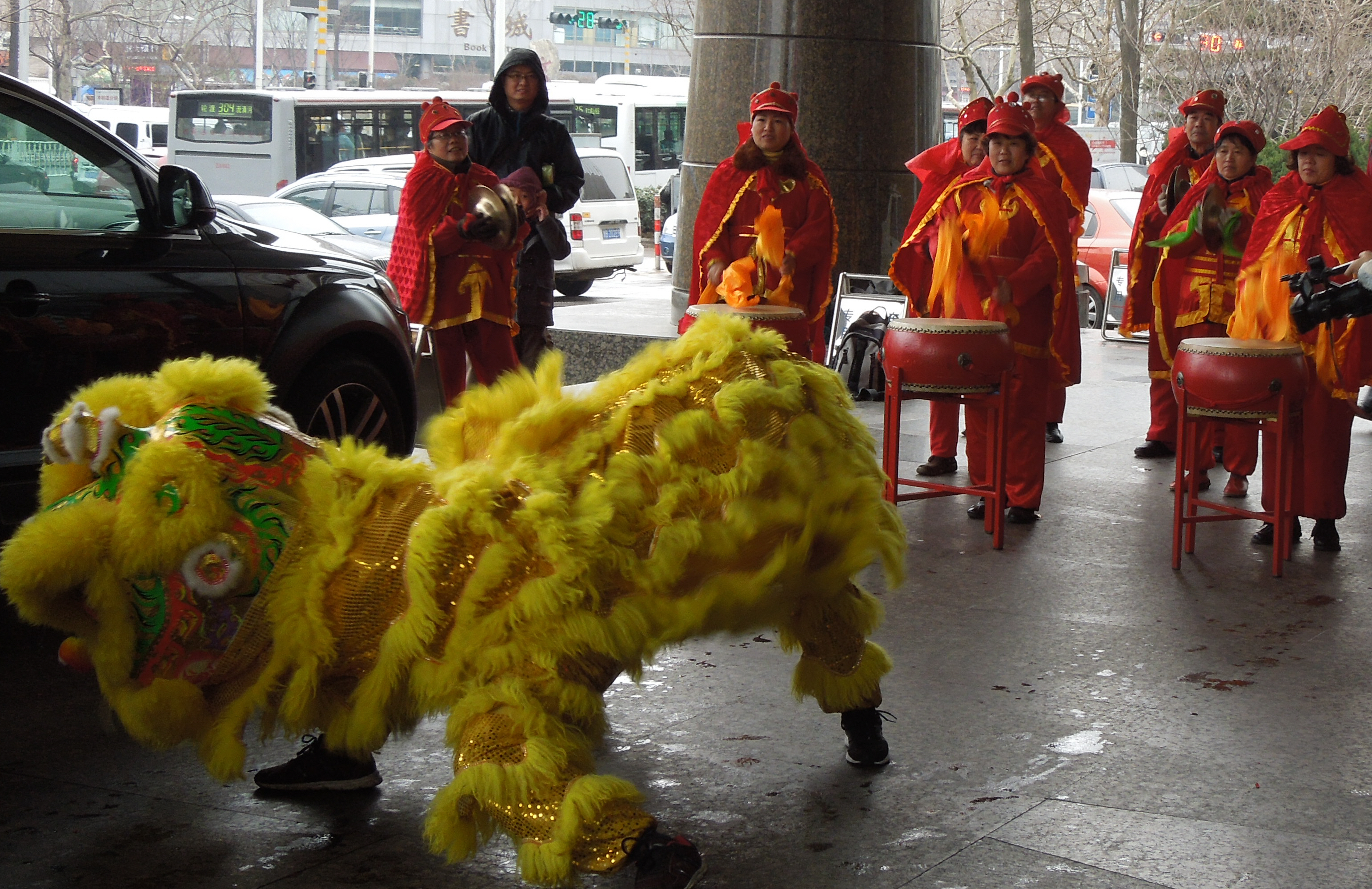 downtown Qingdao. It was chilly, windy and raining. I was standing outside the lobby and seeing—and hearing—a loud music band attired in bright red costume playing traditional music with cymbals and Chinese drums. A black Mercedes with flower decorations pulled in. The music became louder with Chinese dragon dancers joining in the merriment. The bride in Western bridal costume came out. With her was a man in his mid-thirties, He was balding with a receding hairline.
downtown Qingdao. It was chilly, windy and raining. I was standing outside the lobby and seeing—and hearing—a loud music band attired in bright red costume playing traditional music with cymbals and Chinese drums. A black Mercedes with flower decorations pulled in. The music became louder with Chinese dragon dancers joining in the merriment. The bride in Western bridal costume came out. With her was a man in his mid-thirties, He was balding with a receding hairline.
Chinese believe if it rains on the day of wedding, the wife will dominate 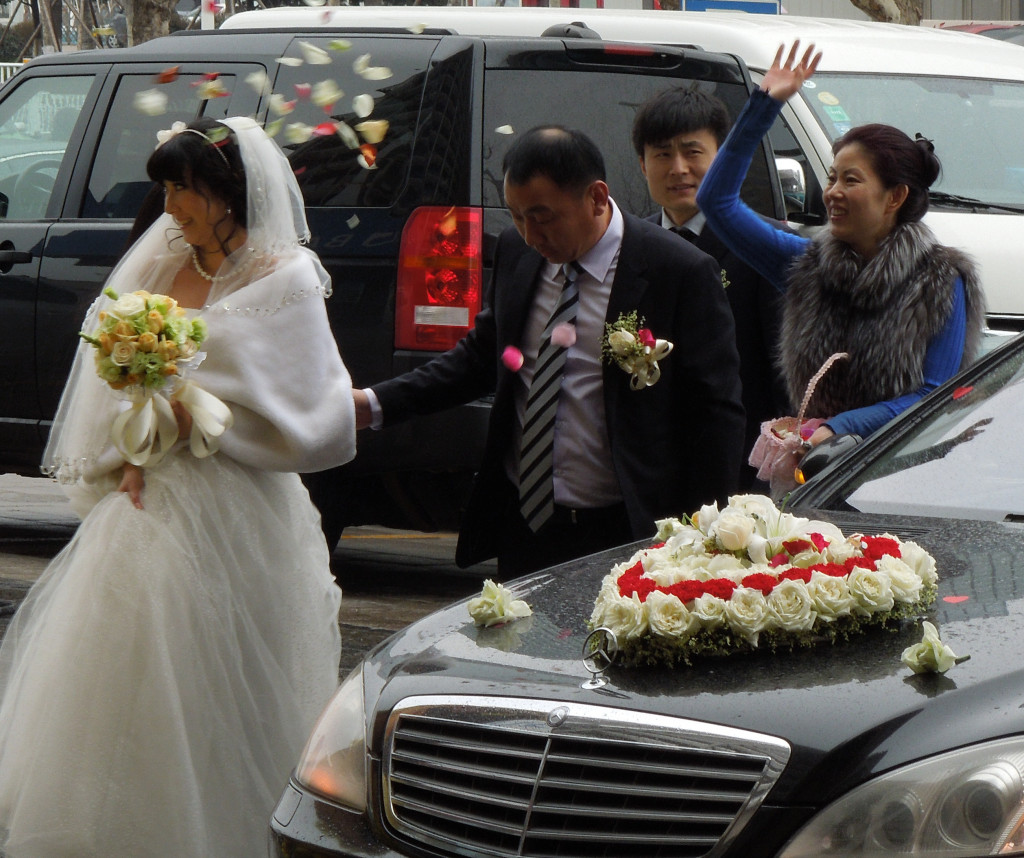 over her husband. My colleagues arrived to take me for lunch. Seeing the rain, they mockingly felt sorry for the groom. The wedding milieu was a good topic during lunch. I asked innocently, “Is the man in dark suit with the bride her uncle or elder brother bringing her to the wedding place?”
over her husband. My colleagues arrived to take me for lunch. Seeing the rain, they mockingly felt sorry for the groom. The wedding milieu was a good topic during lunch. I asked innocently, “Is the man in dark suit with the bride her uncle or elder brother bringing her to the wedding place?”
Surprised at my question, pat came the reply from one of my colleagues, “No. He is the groom!”
“Hmm. He looked old,” I said, “He is getting bald and he has receding hair. Don’t Chinese men get married in their mid twenties?”
This led to a lengthy discussion on the marriage scene among the professionals in today’s China.
As in other parts of the world, tradition runs deep in China. The Chinese Communist Party, trying for decades after the revolution, has ceased to erase traditions on life transitions such as marriage.
In China, it is traditional that the groom pays “bride money” to the bride in person with crisp currency notes. Checks and demand drafts are not accepted—they are against the tradition. Even fifteen years ago, the bride money was manageable—a few thousand renminbis (RMBs), the Chinese currency. $1= 6.3 RMB. The bride has to be satisfied that the man can support her.
Decades ago, the man took his new wife her into the home of his parents to live after wedding. Now things have become expensive, with classy expectations. China’s explosive prosperity is one reason. Another factor is the skewed man-made gender ratio. With a smaller pool of women available for a larger pool of men seeking partners, women are picky.
The typical monthly starting salary for a professional (accountant, lawyer, engineer, physician) in Huangdao is around 60,000 RMBs/year. Now, the bride money for professionals has increased several fold—100,000 RMBs or even more. This is almost twice the starting gross salary.
In addition, the brides, who are in short supply, also expect the grooms to have an apartment to move into after the wedding. And apartments are VERY expensive. A 100-sq.meter (1000 sq. ft), 3-BR apartment in Qingdao in a “desirable” neighborhood costs 800,000 to 1 million RMBs. The down payment is 20%, or 200,000 RMBs.
So, young Chinese professional men need 300,000 RMBs, just to get married, with their starting salary around 60,000 RMBs/year. And the expenses on the wedding day are also on the groom’s family. With normal cars (cost: 80,000 RMBs) — Jaguars are over 600,000 RMBs — becoming a necessity, young men are stressed out.
So, Chinese couples, after having their much-desired boy, not only start to save for his schooling/college, but also for helping their only adult son 25 years down the road with the bride money and apartment.
That explained why the groom at the Crown Plaza Hotel was in his mid-thirties with a receding hairline and was bald. He has been saving money for years for sure. And he was also spending time wooing picky Chinese women to consider him good enough to be their mate.
But this situation is not a panacea for Chinese young women. Even though they demand an apartment before marriage, the apartments are often registered only in the groom’s name. After all, his parents have financed it. But her assets are jointly owned.
But Chinese women today in general, and professional educated women in particular—much like young educated women everywhere—have become picky, sometime too picky for their own good. This is the same as what we see here in the US. Even after the success of the Feminist Movement and the economic security that comes with education, Ivy League women prefer to marry other Ivy Leaguers, and professional women choose other professional men as mates.
My colleagues also told me Chinese men are wary about professional women who come across too aggressive and ambitious. And for single professional women over 32 or 33, the pool of eligible, compatible, unmarried professional men is small and there are not too many to go around. It is a balancing act in the wooing game for the Chinese young men and women. It is quite stressful. The really rich men deploy paid agencies to screen potential candidates. Others depend on parents, relatives and friends to meet women.
If this is the situation for professionals in China, we can only imagine the challenges of the millions of the working poor in China.
The economic impact of this trend is huge. By one estimate, nearly 25% of their 8% annualized GDP growth, or 2%, is because of the demand for new housing and cars among working professionals. This demand sustains basic industries such as steel, cement, home appliances, tiles, bathroom fixtures, construction jobs, home decorations…
With far more men than women in the productive and reproductive age group in China, in the years to come, the married life of Chinese will be dominated by their wives, even if it does not rain on their wedding day.
===========================
An Alternative Critical View on Globalization
By M. D. Nalapat
Editor’s note: The author is vice-chair of Manipal Advanced Research Group and UNESCO peace chair, and professor of geopolitics at Manipal University, India. The article appeared first in China Daily in March, 2013. The Pittsburgh Patrika acknowledges China Daily’s permission to reprint the article.
In the 19th century, the British Empire was a source of pride in the United Kingdom, being a small island that took control of more than half the planet and converted its resources to its advantage. India’s view on the same empire is different, for it saw its share in the global economy fall from 24 percent to less than 1 percent from 1820, when the British began to establish themselves in India, to 1947, the year they left. [Editor’s note: The US experience here is no different. That is why we had a War of Independence in 1776.]
Similarly, the Opium Wars were a source of immense profit for UK merchants, helping huge conglomerates dominate business in Asia and elsewhere. However, for the Chinese people, the Opium Wars were a source of immense pain and the cause of social disintegration that was only reversed in 1949, when the Communist Party of China founded New China.
The reality is that the European experience of colonialism has almost always been a zero-sum game, in which the other side lost heavily in order to ensure gains for the colonizing power. Which is why it is not reasonable for the West to demand that the rest of the world accept its version of history and economic and political doctrines. The circumstances in each non-Western country are very different from those in the West, which is why imposing a Western model would result in a less than optimal outcome. [Note: See what is happening now Afghanistan, Iraq, and Egypt.]
If China has made such great progress, especially since the 1980s, it is because China rejected copying Western commercial institutions, creating instead a model that had a natural fit with Chinese experience and needs. Strangely, while admitting that the Chinese economic model has worked in China, where a purely Western version may have failed, some Western powers constantly criticize China for not adopting a fully Western model of democracy.
Western powers ensured their dominance in the two previous centuries by control of territory. These days, they seek the same outcome by seeking to make other societies believe that following the advice given by them is the best course.
In South America in the 1970s, much misery was caused precisely because governments there strictly followed the orders of the World Bank and the International Monetary Fund, both of which were, and still are, dominated by the West, with only a United States or an European Union national heading these so-called international organizations.
Indeed, to the West, international means the West. The so-called international relations programs taught in the West, which are unfortunately so popular with affluent students in China and India, teach subjects solely through the prism of Western interests. Those graduating out of such programs subconsciously begin to act and think in ways that promote Western interests, rather than that of their own countries. This is hardly surprising.
When the West refers to the international community, it refers only to itself. The views of people in China, India and other large non-Western countries are regarded as not having any worth. In the same way, “international media” refers only to the Western media and to their West-centric viewpoint, ignoring the views of the rest of the world.
Even globalization is taken to mean easier access to Western products, services and people in other markets rather than a genuinely international free flow across borders. The European Union in particular has made entry into its own markets as difficult as possible for companies based in Asia, while constantly putting pressure on this continent to open up markets to the EU. Rather than a Western zero-sum approach, what the world needs is an Asian win-win approach, which is why the rest of the world needs to avoid falling into the trap of judging their own interests solely in the terms set for them by the West. Each country has the right to its own perspective and the right to craft its own path to progress.
India provides an example of a country whose leadership uncritically accepted Western systems when more local solutions were required. Although a democracy, the legal and administrative system in India is largely what it was during British rule. The Indian Penal Code and the Indian Police Act, for example, have not changed for more than a century. Democracy is good for making decisions taking different groups’ interests into consideration, but India has developed at a slow pace. In 1949, the Indian economy was twice as big as China’s. Today, it is less than a third the size.
It costs millions of dollars to fight a parliamentary election in India and in the US, thereby ensuring that only those with access to money will be elected, the poor are effectively excluded.
[Editor’s note: Another Indian example: In the last thirty years, India has transplanted the US healthcare system based on pay-per-service with disastrous consequences for the working class Indians. While this pay-per-service system is being challenged in the US itself both for its efficacy and high costs, it is going full-steam ahead in India with nobody to supervise the performance, pricing, and corrupt marketing practices of doctors, diagnostic labs, and pharmaceutical companies.]
While Western-style democracy may suit Western countries, other countries need to ensure that systems are created that meet local needs. A one-size-fits-all approach makes no sense, except for the West, because if other countries slavishly follow the Western model they will be handicapped from competing with the West.
During the 1997 financial crisis in Asia, which was caused by Western currency speculators, India and China both escaped as both refused to adopt the measures that Western governments were urging them to do. In contrast, countries such as Thailand, which faithfully implemented Western prescriptions, suffered badly. Western prescriptions are good —but only for the West.
Non-Western countries should take care to ensure that their national policies do not get framed in a way that helps outside powers at the expense of their national interests. Democracy implies diversity, not the total adherence to the concepts and models that Western countries promote as universal, but which are really to their advantage. Each country has not only the right but the duty to ensure that diversity is protected and that models suited to their own people and their own history get adopted.
Confidence in one’s own people is essential to make the sort of immense progress that China has achieved over the past three decades. Such confidence cannot be transplanted from the outside. It has to develop from within a country and its unique people.
======================
Shakuntala Devi – A Remembrance
By Samar K. Saha
e-mail: sksaha@uss.com
I first met Shakuntala Devi ‘Banerji’ in 1988 at her Manhattan apartment. She remained an enigma to me all these years. In normal conversations, appearance, and discussions, she was full of life — an extrovert, witty, very social, simple, down-to-earth, comfortable in any setting, and a 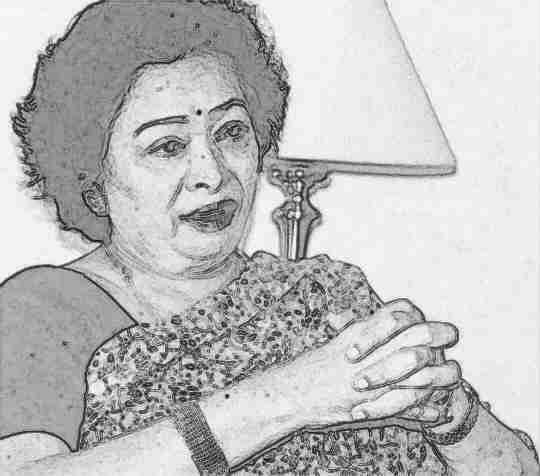 loving person. She treated me like her younger brother in distress during later meets. I could feel that whiff of affection each time I saw her. She passionately talked about her love for Fred Astaire–Ginger Rogers movies, cooking, and reading. Nothing showed any trace of a supernatural mind. She simply described her ability as a ‘God’s Gift’ when asked — just as another great Indian mathematician Ramanujan had once remarked about himself.
loving person. She treated me like her younger brother in distress during later meets. I could feel that whiff of affection each time I saw her. She passionately talked about her love for Fred Astaire–Ginger Rogers movies, cooking, and reading. Nothing showed any trace of a supernatural mind. She simply described her ability as a ‘God’s Gift’ when asked — just as another great Indian mathematician Ramanujan had once remarked about himself.
The Beginning and the Fame: Shakuntala Devi was born in Bangalore, India, to an orthodox Kannada Brahmin family on November 4, 1929. Her father chose to be a circus acrobat. Devi’s mathematical gift first demonstrated itself while she was doing card tricks with her father when she was three. Those present noticed that she “beat” them by memorizing the cards rather than by sleight of hand. Devi was quoted as saying. “At the age of 6, I gave my first major show at the University of Mysore (India).” The word spread quickly of her supernatural capability.
Shakuntala Devi went on tours around the world starting in the ‘50s and performed in a number of institutions, theaters and on television up to the early 80’s. During one such trip in the early 50’s, she met Albert Einstein. A reporter recounted the meet from Einstein’s note to Devi. Albert Einstein says in the note, “I asked this woman a question which I take three hours to solve because I have to follow a whole method …. I know that nobody can do it in less time than I can… And the whole procedure has to be followed. The figures were so big that it took the whole board for her to write the answer. And before I had even finished the question, she started writing the answer.” Einstein was absolutely puzzled. He asked, “How do you do it?” Devi said, “I don’t know … — it simply happens. You ask me and figures start appearing before my eyes, somewhere inside. I can see 1, 2, 3, and I just go on writing…..”
Live Demonstrations – Some Exceptional Examples:
Guinness Book of Records contains many other recorded feats of Devi. Here are some:
• In January 1977, Devi received a standing ovation from an audience of erudite mathematicians at the Southern Methodist University in Dallas, Texas, when she extracted the 23rd root of a 201-digit number, at the fifty-second mark, with the correct answer being ’546372891′. She was faster than the fastest computer, UNIVAC’s time of 62 seconds.
• In June, 1980, Devi demonstrated the multiplication of two 13-digit numbers: (7,686,369,774,870) X (2,465,099,745,779), picked randomly by the Computer Department of Imperial College, London. This event is mentioned in the 1995 Guinness Book of Records. Her correct answer of 18,947,668,177,995,426,462,773,730 came in just 28 seconds.
• In 1988 Devi visited Stanford University at the invitation of Professor Arthur Jensen. Jensen, an educational psychologist, tried to understand the source of Devi’s abilities. According to Jensen, ‘’Devi solved most of the problems faster than I was able to copy them in my notebook.’’ Jensen could only suggest that Devi perceived large numbers differently from others. ‘’For a calculating prodigy like Devi, the manipulation of numbers is apparently like a native language, whereas for most of us, arithmetic calculation is at best like the foreign language we learnt at school,’’ he wrote.
Family Life: Shakuntala Devi married Paritosh Banerji, a senior IAS officer from Kolkata in the mid-1960s. They had a daughter, Anupama Banerji, from this marriage. The marriage ended in divorce in 1979. In the 1980’s Shakuntala Devi returned to Bangalore with her daughter, where she continued with book writing. During this period she entered the mystic world of astrology, offering astrological advices to people, including celebrities and politicians. She also set up an ‘Educational Foundation Public Trust’ to promote mathematical, astrological and philosophical studies.
With severe respiratory problems, she was admitted to a hospital in Bangalore on April 3, 2013. Her health began to deteriorate rapidly after her kidneys failed and she breathed her last on April 21, 2013.
I often wonder who was she?
Major Writings:
Critically appraised Puzzles to Puzzle You is one of Shakuntala Devi’s best works for aspiring and budding mathematicians.
Perfect Murder is the tale of a successful lawyer-turned-killer and is regarded as a fine work of fiction.
The World of Homosexuals, published in 1977, considered a courageous work on a controversial issue and was included in the ‘Top 100 Books by Indian Authors’ in 2005.
The Wonderland of Numbers published by Orient paperbacks in 2006 is a fictional story of a girl, Neha and her fascination with numbers.
=======================
Caring for Values in Our Pursuits
By Sriram Palghat, Upper St. Clair, PA
e-mail: palghat@gmail.com
Recent incidents such as the shooting in the Connecticut school and the brutal gang-rape of a woman in New Delhi made me wonder what is driving men to commit such unimaginably violent acts?
Our busy, materialistic society is stretching us thin, not giving us any time to think of anything other than chasing our worldly pursuits. Along the way some people discard their moral and ethical groundings.
Religion is important in upholding the moral and ethical values of a society. However, men and women today are hardly finding time to even think of religion and values. An example of this is the closing down of churches in the US due to lack of interest and faith among younger generations. Technology is not helping the situation either. Smart phones and pagers make people think of work even in sleep.
is Holiness the Dalai Lama says, “Because… individuals [in society] derail from their values and behave negatively, there is more and more madness today. If their numbers increase, all of society will suffer. If we utilize and understand religious traditions properly, individuals benefit, and so can society as a whole.”
The question we must ask ourselves is, “Are we promoting the material-oriented dynamics without caring too much about the need for nurturing value-oriented lifestyle?” It is important for people to pause from time to time and think of the values we pursue. Every individual owes this time of reflection to oneself and to society at large. Many religious organizations are organizing religious events and retreats, providing us triggers to reflect on our pursuits.
n Pittsburgh, the Chinmaya Mission is organizing a Bhagavata Saptaah from Sunday, August 11 to Sunday, August 18 at the Chinmaya Sanjeevani in Monroeville. In this 8-day event, you will listen to stories from the Bhagavatam discussing ethical issues and conflicts that are as relevant today.
Opportunities like this help us to recognize how we can incorporate positive values into our lifestyle to find peace within ourselves so that we can find peace around ourselves. This is a great opportunity for us to unplug from our stressful daily aggravations and get immersed in listening to the stories from our epics and get rejuvenated.
Amidst the busy lifestyle of the current society, as Seekers of Truth, we need to make an effort to set aside some time for such events. We all need triggers to bring about desirable changes in our lives.
=========================
Guru Jaya Man’s 100 Arangetrams
By S. V. Krishnaswamy, Baltimore, MD
e-mail: krish15146@yahoo.com
Editor’s Note: S. V. Krishnsawamy lived in Monroeville for very many years before moving to Maryland. He interviewed Jaya Mani for the Patrika in 2003. He talked to Jaya recently on her 100th Arangetram on various subjects seemingly disjointed, but all related to, arangetrams.
Seeing one hundred students through their arangetrams is an achievement for any dance teacher anywhere. More so in the Pittsburgh metro area with barely 15,000 Indians. In June, Jaya’s 100th student had her arangetram. Thirty-five years ago, in 1971 with help from Rajashri Rajgopal (who lives in Northern Virginia now), Jaya started teaching Bharatanatyam with six students. Now, with over six dance teachers here, Jaya continues with over 100 students, taking three to four students to arangetram every year. It has been a long and exhilarating journey for Jaya. That her students trace their heritage to almost every part of India is a testimony to Jaya Mani as a teacher.
Seamlessly Integrating Technologies: These days Jaya encourages her students getting ready for arangetram to do their own web searches to get the details of the ragam, talam, composer and other information about the songs. Then she explains the meaning of the lyrics, their background and context. This allows them to be better prepared than before the advent of the web resources.
Grooming Future Teachers: When asked if she is grooming any of her students to become a teacher, Jaya says, “Some students after arangetrams continue with advanced lessons from me. If they have the commitment and the rigor to teach, I encourage them. One of my students, Shobita Ravi, is teaching in Wexford.”
Before coming to the US, Jaya taught her niece Bharatanatyam in Chennai. After arangetram, her niece studied nattuvangam (the Tamil technical term for choreography) in the Iyal Isai Nataka Manram in Chennai. She is teaching Bharatanatyam in Melbourne, Australia, where her first student’s arangetram is coming soon. Jaya will be presiding over her first grand-student’s arangetram there. Another milestone for Jaya.
Preserving the Dance Repertoire: Jaya tries to preserve the arangetram music and actual performance by converting old audio & video cassettes into DVDs, MP3, I-tunes etc. She was disappointed that several old tapes were spoiled in storage. Asked if she is planning to make her collection of music available for young teachers, Jaya says she is willing to make them available for her students if they are is serious about using them in any performance.
Jaya became emotional recalling that her father, who supported her throughout her dancing career, saw several of her students’ arangetrams in person in Pittsburgh.
Challenges in Using Live Music: “I have accomplished most of what I set out for myself when I started teaching three decades ago,†She says, “My only disappointment is that I am not able to routinely incorporate live orchestra in arangetrams.†This is because of the logistical constraints and the winter weather. She lives in Slippery Rock, more than an hour’s drive from Pittsburgh. However, she is happy that she supports musicians in Chennai using their recorded music in arangetrams.
With so many arangetrams completed, her students have a number of dance dresses and jewelry. When asked what they do with these when they no longer need them, Jaya admits, “It is the parents’ decision. Some want to keep them as souvenirs, and some lend them for other children.” Some parents and Jaya herself, have lent the dresses to students going through arangetrams.
On the General Baharatanatyam Scene Today: Isai velalar nattuvanars (choreographers in Tamil), have composed superb varnams, padams and tillanas for dance. Nattuvanars were all men—the term is masculine in Tamil. Till the mid-20th century, nattuvanars held a pre-eminent place in arangetrams. However, with the mostly English-educated upper class women taking over choreography, we witness the decline of nattuvanars. They are replaced by those who do only the Sollu-kattu, and yet are said to do nattuvangam! Now he/she is one in the music ensemble instead of being at the center of the dance program.
However, veterans like Adyar Lakshmanan, C V Chandrasekhar, the Dhananjayans, Narasimhacharis, and K J Sarasa carry on the old-time nattuvangam. Similarly, even though dancers like Balasaraswathy, Rukmini Devi, and Padma Subramaniam have composed Varnams and Padams, they are rare. Today’s mostly English-educated choreographers do not have the skills — Indian languages, grasp of history and mythologies, epics, philosophy, and literary skills and poetical talent — required to compose lyrics. So, I asked Jaya, “What is the contribution of today’s choreographers for the dance repertoire?”
While recognizing the lack of compositions by dance teachers/choreographers themselves, Jaya is confident the young composers will fill the gap. She gave an example of her interaction years ago with a young violinist who composed music for her using the works from Tamil Bhakti literature and from contemporary poets. He is B V Raghavendra Rao, a leading violinist now. Jaya feels modern-day choreographers need to identify such talents and work with them.
“Why is that today’s dance teachers are reluctant to use the excellent classically tuned film songs by poets like Udumalai Narayana Kavi, Pattukkottai Kalyanasundaram, Kannadasan, and others in recitals?”
Jaya: “If the music and lyrics suit the dance theme, then surely one can use their songs.” She gave examples of lyrics of film songs she helped her students to use for fundraising events.
Taking Bharatanatyam to Universities Here: Jaya is now teaching Bharatanatyam at the Slippery Rock University one semester a year. Â In her class typically over thirty American students register.
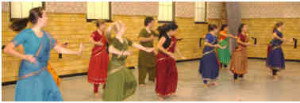
“What can anyone can learn in one semester?” I asked.
Jaya unhesitatingly says, “These are dedicated dance majors. They quickly grasp the basic adavus, jatis and learn alarippu, kolattam and few basic dance pieces in one semester.” Continuing, she said, “These students go to Chennai during the summer to get immersed in the Indian dance scene there under the guidance of Revathy Ramachandran.â”
On Saturday, June 15, Jaya’S students celebrated her contributions to our community in a function held at the S.V. Temple.
We congratulate Jaya for implanting the nuances of Indian performing arts in the minds of our youngsters born and raised here, not an easy task by any means. We also thank her for nurturing in our youngsters the culture, and the very core of our faith that is woven into the dance repertoire. We wish her well for many more arangetrams.
=========================

